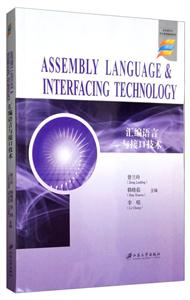-
>
爱因斯坦在路上:科学偶像的旅行日记
-
>
鸟有什么好看的
-
>
行星的故事:图解太阳系行星探索发现
-
>
现代科学技术名词选编(初版)
-
>
文化人类学百科全书(全二册)(精装)
-
>
法医笔记:死亡背后的真相
-
>
贪婪的多巴胺
汇编语言与接口技术=ASSEMBLY LANGUAGE & INTERFACING TECHNOLOGY 版权信息
- ISBN:9787568408554
- 条形码:9787568408554 ; 978-7-5684-0855-4
- 装帧:一般胶版纸
- 册数:暂无
- 重量:暂无
- 所属分类:>
汇编语言与接口技术=ASSEMBLY LANGUAGE & INTERFACING TECHNOLOGY 内容简介
Today's digital technology, computer technology have penetrated into various fields. The ability to master and apply computer technology has become one of the criten.a to measure the quality of a professional technicians. Assembly Language & Interfaang Technology is an important computer technology course in science and engineering of higher education. Although the rapid development of computer technology, microprocessors have been from 32 to 64-bit transition, for a variety of control systems, we commonly use 8-bit, 16-bit interface technology to meet the appli.cation requirements, so 32 or even 64 microprocessor to explain the working principle of microcomputers is not suitable. This book is a 16-bit microprocessor model, about the basic principles of computer and interface technology, easy to learn and understand, its basic concepts, basic ideas and basic methods and 32-bit processor are the same. This book is mainly for the general colleges and universities of computer science, electromechanical contror and non-electronics majors students. The preparation of this book focuses on theory with practice and engineering applications. In the preparation of teaching materials in the introduction oflife ,a lot of examples witch are easy to understand are used to help readers understand the basic concepts of computer. After talking about the working pri.nciple of various interface chips, the book g:ives a number of examples which can be directly applied, and give some different solutions to achieve the function. The book is divided into 7 chapters. Chapter 1 introduces the basics of comicrocomprter systems; Chapter 2 introduces assembly language in graphical form; Chapter 3 introduces the assembly language programming method; Chapter 4 introduces the 16-bit processor Pins, read and write timing; Chapter 5 describes the I/O interface, the basic composition, read and write technology and data transfer; Chapter 6 introduces the concept of interrupts and functions of programming 8259A chip. Chapter 7 introduces the internal structure and programming of the programmable parallel interface chip 8255A, the serial interface chip 8251A, and the timer/counter interface chip 8253/8254. This book is comprehensive, and self-contained, the assembly language prograrrurung part and the computer principle and interface technology are orgamied together, through appropriate choice, and is suitable both computer professional and non-computer professional students. This book is writen by Zeng Lanl.ing, Han Xiaoru, and Li chang; Adjardiah Winffed Kudjo Patrick as deputy editors. The authors of this book in the process of writing referred to a lot of excellent reference materials, thanks to the author of these materials, in particular, thanks especially to Ma Weihua, Qian Xiajie and Yang Wenxian. In addition, the writing of this book has been the national teaching quality engineering network of professional comprehensive reform project and Jiangsu University teaching reform project support. Due to the limitation of editors, there are some errors and omission, please critilize. Ifyou encounter problems with the use of the textbook, contact the author. E-Mail: lanling@ujs. edu. cn.
汇编语言与接口技术=ASSEMBLY LANGUAGE & INTERFACING TECHNOLOGY 目录
1.1 Development and application
1.1.1 Development of electronic computer
1.1.2 Development of microcomputer
1.1.3 Application of microcomputer
1.2 Composition of microcomputer
1.2.1 Hardware system of microcomputer
1.2.2 Software system of microcomputer
1.2.3 Main performance indicator of microcomputer
1.3 Number and coding of computer
1.3.1 The conversion between the carry count system and the incoming system
1.3.2 The representation of the number in the computer
1.3.3 Coding in computer
Exercise
CHAPTER 2 ASSEMBLY LANGUAGE BASICS
2.1 Assembly language overview
2.2 8086/8088 microprocessor programming structure
2.2.1 8086/8088 functional structure
2.2.2 8086/8088 memory organization
2.2.3 8086/8088 register structure
2.3 Assembly language program on the machine debugging
2.3.1 Simple assembly language source
2.3.2 Editing
2.3.3 Compilation
2.3.4 Connecting
2.3.5 0peration and debugging
2.4 Assembly language source organization
2.4.1 Assembly language statements
2.4.2 Assembly language source program format
2.5 0perands in assembly language
2.5.1 Constant
2.5.2 Variables and labels
2.5.3 Expression
2.5.4 Symbol definition
2.6 8086/8088 addressing mode
2.6.1 Immediate addressing
2.6.2 Register addressing
2.6.3 Direct addressing
2.6.4 Register in direct addressing
2.6.5 Register relative addressing
2.6.6 Base indexed addressing
2.6.7 Relative base indexed addressing
2.7 8086/8088 instruction system
2.7.1 Data transfer class instructions
2.7.2 Arithmetic operations instructions
2.7,3 Logical and shift class instructions
2.7.4 Program control class instructions
2.7.5 Processor control instructions
2.8 Basic IO function call
2.8.1 Keypad function call (INT 21H)
2.8.2 Display function call (INT 21H)
Exercise
……
CHAPTER 3 ASSEMBLY LANGUAGE PROGRAMMING
CHAPIER 4 16-BIT MICROPROCESSOR EXTERNAL FEATURES
CHAPTER 5 MICROCOMPUTER INPUT AND OUTPUT TECHNOLOGY
CHAPTER 6 INTERRUPTION SYSTEM FOR MICROCOMPUTERS
CHAPTER 7 PROGRAMMABLE INTERFACE CHIP
REFERENCES
APPENDIX
- >
大红狗在马戏团-大红狗克里弗-助人
大红狗在马戏团-大红狗克里弗-助人
¥3.9¥10.0 - >
李白与唐代文化
李白与唐代文化
¥9.9¥29.8 - >
烟与镜
烟与镜
¥25.1¥48.0 - >
回忆爱玛侬
回忆爱玛侬
¥12.5¥32.8 - >
苦雨斋序跋文-周作人自编集
苦雨斋序跋文-周作人自编集
¥6.9¥16.0 - >
有舍有得是人生
有舍有得是人生
¥19.4¥45.0 - >
二体千字文
二体千字文
¥16.0¥40.0 - >
推拿
推拿
¥12.2¥32.0
-
科学全知道-那些古怪有趣的科学现象
¥14.4¥45 -
超级思维-用理工科思维推算世界
¥10.5¥32.8 -
疯狂知识杂货店/意林
¥12.5¥39 -
我的世界观
¥10.8¥36 -
那些稀奇古怪的冷知识.JPG那些稀奇古怪的冷知识
¥14.4¥45 -
通俗天文学(2019版)
¥15.4¥48















